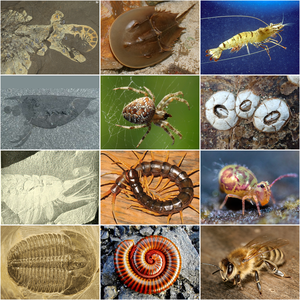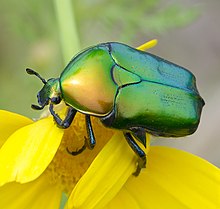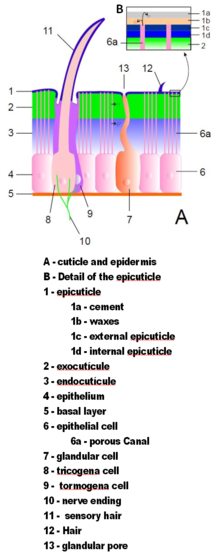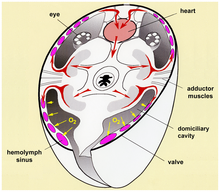ARTHROPOD
Arthropod
131 languages
Tools
 From Wikipedia, the free encyclopedia
From Wikipedia, the free encyclopedia
Not to be confused with Anthropod.
Arthropoda
Temporal range: 538.8 –0 Ma PreꞒ
Earliest Cambrian (Fortunian)–Recent Scientific classification
Scientific classification![]() Domain:EukaryotaKingdom:AnimaliaSubkingdom:EumetazoaClade:ParaHoxozoaClade:BilateriaClade:Nephrozoa(unranked):ProtostomiaSuperphylum:Ecdysozoa(unranked):Panarthropoda(unranked):TactopodaPhylum:Arthropoda
Domain:EukaryotaKingdom:AnimaliaSubkingdom:EumetazoaClade:ParaHoxozoaClade:BilateriaClade:Nephrozoa(unranked):ProtostomiaSuperphylum:Ecdysozoa(unranked):Panarthropoda(unranked):TactopodaPhylum:Arthropoda
Gravenhorst, 1843[1][2]Subphyla, unplaced genera, and classesshow
Diversityaround 1,170,000 species.SynonymsCondylipoda Latreille, 1802
Arthropods (/ˈɑːrθrəpɒd/) are invertebrates in the phylum Arthropoda. They possess an exoskeleton with a cuticle made of chitin, often mineralised with calcium carbonate, a body with differentiated (metameric) segments, and paired jointed appendages. In order to keep growing, they must go through stages of moulting, a process by which they shed their exoskeleton to reveal a new one. They are an extremely diverse group, with up to 10 million species.
Haemolymph is the analogue of blood for most arthropods. An arthropod has an open circulatory system, with a body cavity called a haemocoel through which haemolymph circulates to the interior organs. Like their exteriors, the internal organs of arthropods are generally built of repeated segments. Their nervous system is "ladder-like", with paired ventral nerve cords running through all segments and forming paired ganglia in each segment. Their heads are formed by fusion of varying numbers of segments, and their brains are formed by fusion of the ganglia of these segments and encircle the esophagus. The respiratory and excretory systems of arthropods vary, depending as much on their environment as on the subphylum to which they belong.
Arthropods use combinations of compound eyes and pigment-pit ocelli for vision. In most species, the ocelli can only detect the direction from which light is coming, and the compound eyes are the main source of information, but the main eyes of spiders are ocelli that can form images and, in a few cases, can swivel to track prey. Arthropods also have a wide range of chemical and mechanical sensors, mostly based on modifications of the many bristles known as setae that project through their cuticles. Similarly, their reproduction and development are varied; all terrestrial species use internal fertilization, but this is sometimes by indirect transfer of the sperm via an appendage or the ground, rather than by direct injection. Aquatic species use either internal or external fertilization. Almost all arthropods lay eggs, with many species giving birth to live young after the eggs have hatched inside the mother; but a few are genuinely viviparous, such as aphids. Arthropod hatchlings vary from miniature adults to grubs and caterpillars that lack jointed limbs and eventually undergo a total metamorphosis to produce the adult form. The level of maternal care for hatchlings varies from nonexistent to the prolonged care provided by social insects.
The evolutionary ancestry of arthropods dates back to the Cambrian period. The group is generally regarded as monophyletic, and many analyses support the placement of arthropods with cycloneuralians (or their constituent clades) in a superphylum Ecdysozoa. Overall, however, the basal relationships of animals are not yet well resolved. Likewise, the relationships between various arthropod groups are still actively debated. Today, arthropods contribute to the human food supply both directly as food, and more importantly, indirectly as pollinators of crops. Some species are known to spread severe disease to humans, livestock, and crops.
Etymology[edit]
The word arthropod comes from the Greek ἄρθρον árthron 'joint', and πούς pous (gen. ποδός podos) 'foot' or 'leg', which together mean "jointed leg",[19] with the word "arthropodes" initially used in anatomical descriptions by Barthélemy Charles Joseph Dumortier published in 1832.[1] The designation "Arthropoda" appears to have been first used in 1843 by the German zoologist Johann Ludwig Christian Gravenhorst (1777–1857).[20][1] The origin of the name has been the subject of considerable confusion, with credit often given erroneously to Pierre André Latreille or Karl Theodor Ernst von Siebold instead, among various others.[1]
Terrestrial arthropods are often called bugs.[Note 1] The term is also occasionally extended to colloquial names for freshwater or marine crustaceans (e.g., Balmain bug, Moreton Bay bug, mudbug) and used by physicians and bacteriologists for disease-causing germs (e.g., superbugs),[23] but entomologists reserve this term for a narrow category of "true bugs", insects of the order Hemiptera.[23]
Description[edit]
Arthropods are invertebrates with segmented bodies and jointed limbs.[24] The exoskeleton or cuticles consists of chitin, a polymer of N-Acetylglucosamine.[25] The cuticle of many crustaceans, beetle mites, the clades Penetini and Archaeoglenini inside the beetle subfamily Phrenapatinae,[26] and millipedes (except for bristly millipedes) is also biomineralized with calcium carbonate. Calcification of the endosternite, an internal structure used for muscle attachments, also occur in some opiliones,[27] and the pupal cuticle of the fly Bactrocera dorsalis contains calcium phosphate.[28]
Diversity[edit]
 Protaetia cuprea (copper chafer). Beetles are the largest and most diverse order of arthropods.
Protaetia cuprea (copper chafer). Beetles are the largest and most diverse order of arthropods.
Arthropoda is the largest animal phylum with the estimates of the number of arthropod species varying from 1,170,000 to 5 to 10 million and accounting for over 80 per cent of all known living animal species.[29][30] One arthropod sub-group, the insects, includes more described species than any other taxonomic class.[31] The total number of species remains difficult to determine. This is due to the census modeling assumptions projected onto other regions in order to scale up from counts at specific locations applied to the whole world. A study in 1992 estimated that there were 500,000 species of animals and plants in Costa Rica alone, of which 365,000 were arthropods.[31]
They are important members of marine, freshwater, land and air ecosystems and one of only two major animal groups that have adapted to life in dry environments; the other is amniotes, whose living members are reptiles, birds and mammals.[32] Both the smallest and largest arthropods are crustaceans. The smallest belong to the class Tantulocarida, some of which are less than 100 micrometres (0.0039 in) long.[33] The largest are species in the class Malacostraca, with the legs of the Japanese spider crab potentially spanning up to 4 metres (13 ft)[34] and the American lobster reaching weights over 20 kg (44 lbs).
Segmentation[edit]
_______________________
_______________________
_______________________
Segments and tagmata of an arthropod[32]
 Structure of a biramous appendage.[35]
Structure of a biramous appendage.[35]
The embryos of all arthropods are segmented, built from a series of repeated modules. The last common ancestor of living arthropods probably consisted of a series of undifferentiated segments, each with a pair of appendages that functioned as limbs. However, all known living and fossil arthropods have grouped segments into tagmata in which segments and their limbs are specialized in various ways.[32]
The three-part appearance of many insect bodies and the two-part appearance of spiders is a result of this grouping.[36] There are no external signs of segmentation in mites.[32] Arthropods also have two body elements that are not part of this serially repeated pattern of segments, an ocular somite at the front, where the mouth and eyes originated,[32][37] and a telson at the rear, behind the anus.
Originally it seems that each appendage-bearing segment had two separate pairs of appendages: an upper, unsegmented exite and a lower, segmented endopod. These would later fuse into a single pair of biramous appendages united by a basal segment (protopod or basipod), with the upper branch acting as a gill while the lower branch was used for locomotion.[38][39][35] The appendages of most crustaceans and some extinct taxa such as trilobites have another segmented branch known as exopods, but whether these structures have a single origin remain controversial.[40][41][35] In some segments of all known arthropods the appendages have been modified, for example to form gills, mouth-parts, antennae for collecting information,[36] or claws for grasping;[42] arthropods are "like Swiss Army knives, each equipped with a unique set of specialized tools."[32] In many arthropods, appendages have vanished from some regions of the body; it is particularly common for abdominal appendages to have disappeared or be highly modified.[32] Alignment of anterior body segments and appendages across various arthropod taxa, based on the observations until the mid 2010s. Head regions in black.[37][43]
Alignment of anterior body segments and appendages across various arthropod taxa, based on the observations until the mid 2010s. Head regions in black.[37][43]
The most conspicuous specialization of segments is in the head. The four major groups of arthropods – Chelicerata (sea spiders, horseshoe crabs and arachnids), Myriapoda (symphylan, pauropods, millipedes and centipedes), Pancrustacea (oligostracans, copepods, malacostracans, branchiopods, hexapods, etc.), and the extinct Trilobita – have heads formed of various combinations of segments, with appendages that are missing or specialized in different ways.[32] Despite myriapods and hexapods both having similar head combinations, hexapods are deeply nested within crustacea while myriapods are not, so these traits are believed to have evolved separately. In addition, some extinct arthropods, such as Marrella, belong to none of these groups, as their heads are formed by their own particular combinations of segments and specialized appendages.[44]
Working out the evolutionary stages by which all these different combinations could have appeared is so difficult that it has long been known as "The arthropod head problem".[45] In 1960, R. E. Snodgrass even hoped it would not be solved, as he found trying to work out solutions to be fun.[Note 2]
Exoskeleton[edit]
Main article: Arthropod exoskeleton
Arthropod exoskeletons are made of cuticle, a non-cellular material secreted by the epidermis.[32] Their cuticles vary in the details of their structure, but generally consist of three main layers: the epicuticle, a thin outer waxy coat that moisture-proofs the other layers and gives them some protection; the exocuticle, which consists of chitin and chemically hardened proteins; and the endocuticle, which consists of chitin and unhardened proteins. The exocuticle and endocuticle together are known as the procuticle.[47] Each body segment and limb section is encased in hardened cuticle. The joints between body segments and between limb sections are covered by flexible cuticle.[32]
The exoskeletons of most aquatic crustaceans are biomineralized with calcium carbonate extracted from the water. Some terrestrial crustaceans have developed means of storing the mineral, since on land they cannot rely on a steady supply of dissolved calcium carbonate.[48] Biomineralization generally affects the exocuticle and the outer part of the endocuticle.[47] Two recent hypotheses about the evolution of biomineralization in arthropods and other groups of animals propose that it provides tougher defensive armor,[49] and that it allows animals to grow larger and stronger by providing more rigid skeletons;[50] and in either case a mineral-organic composite exoskeleton is cheaper to build than an all-organic one of comparable strength.[50][51]
The cuticle may have setae (bristles) growing from special cells in the epidermis. Setae are as varied in form and function as appendages. For example, they are often used as sensors to detect air or water currents, or contact with objects; aquatic arthropods use feather-like setae to increase the surface area of swimming appendages and to filter food particles out of water; aquatic insects, which are air-breathers, use thick felt-like coats of setae to trap air, extending the time they can spend under water; heavy, rigid setae serve as defensive spines.[32]
Although all arthropods use muscles attached to the inside of the exoskeleton to flex their limbs, some still use hydraulic pressure to extend them, a system inherited from their pre-arthropod ancestors;[52] for example, all spiders extend their legs hydraulically and can generate pressures up to eight times their resting level.[53]
Moulting[edit]
Main article: Ecdysis Cicada climbing out of its exuviae while attached to tree
Cicada climbing out of its exuviae while attached to tree
The exoskeleton cannot stretch and thus restricts growth. Arthropods, therefore, replace their exoskeletons by undergoing ecdysis (moulting), or shedding the old exoskeleton, the exuviae, after growing a new one that is not yet hardened. Moulting cycles run nearly continuously until an arthropod reaches full size. The developmental stages between each moult (ecdysis) until sexual maturity is reached is called an instar. Differences between instars can often be seen in altered body proportions, colors, patterns, changes in the number of body segments or head width. After moulting, i.e. shedding their exoskeleton, the juvenile arthropods continue in their life cycle until they either pupate or moult again.[54]
In the initial phase of moulting, the animal stops feeding and its epidermis releases moulting fluid, a mixture of enzymes that digests the endocuticle and thus detaches the old cuticle. This phase begins when the epidermis has secreted a new epicuticle to protect it from the enzymes, and the epidermis secretes the new exocuticle while the old cuticle is detaching. When this stage is complete, the animal makes its body swell by taking in a large quantity of water or air, and this makes the old cuticle split along predefined weaknesses where the old exocuticle was thinnest. It commonly takes several minutes for the animal to struggle out of the old cuticle. At this point, the new one is wrinkled and so soft that the animal cannot support itself and finds it very difficult to move, and the new endocuticle has not yet formed. The animal continues to pump itself up to stretch the new cuticle as much as possible, then hardens the new exocuticle and eliminates the excess air or water. By the end of this phase, the new endocuticle has formed. Many arthropods then eat the discarded cuticle to reclaim its materials.[54]
Because arthropods are unprotected and nearly immobilized until the new cuticle has hardened, they are in danger both of being trapped in the old cuticle and of being attacked by predators. Moulting may be responsible for 80 to 90% of all arthropod deaths.[54]
Internal organs[edit]
= heart
= gut
= brain / ganglia
O = eye
Basic arthropod body structure
Arthropod bodies are also segmented internally, and the nervous, muscular, circulatory, and excretory systems have repeated components.[32] Arthropods come from a lineage of animals that have a coelom, a membrane-lined cavity between the gut and the body wall that accommodates the internal organs. The strong, segmented limbs of arthropods eliminate the need for one of the coelom's main ancestral functions, as a hydrostatic skeleton, which muscles compress in order to change the animal's shape and thus enable it to move. Hence the coelom of the arthropod is reduced to small areas around the reproductive and excretory systems. Its place is largely taken by a hemocoel, a cavity that runs most of the length of the body and through which blood flows.[55]
Respiration and circulation[edit]
See also: Hemolymph and hemocyte Respiration and circulation in a myodocopid ostracod. Simplified transverse section through anterior body and carapace, showing gaseous diffusion through the inner lamella of the carapace (yellow arrows)
Respiration and circulation in a myodocopid ostracod. Simplified transverse section through anterior body and carapace, showing gaseous diffusion through the inner lamella of the carapace (yellow arrows)
Arthropods have open circulatory systems. Most have a few short, open-ended arteries. In chelicerates and crustaceans, the blood carries oxygen to the tissues, while hexapods use a separate system of tracheae. Many crustaceans and a few chelicerates and tracheates use respiratory pigments to assist oxygen transport. The most common respiratory pigment in arthropods is copper-based hemocyanin; this is used by many crustaceans and a few centipedes. A few crustaceans and insects use iron-based hemoglobin, the respiratory pigment used by vertebrates. As with other invertebrates, the respiratory pigments of those arthropods that have them are generally dissolved in the blood and rarely enclosed in corpuscles as they are in vertebrates.[55]
The heart is a muscular tube that runs just under the back and for most of the length of the hemocoel. It contracts in ripples that run from rear to front, pushing blood forwards. Sections not being squeezed by the heart muscle are expanded either by elastic ligaments or by small muscles, in either case connecting the heart to the body wall. Along the heart run a series of paired ostia, non-return valves that allow blood to enter the heart but prevent it from leaving before it reaches the front.[55]
Arthropods have a wide variety of respiratory systems. Small species often do not have any, since their high ratio of surface area to volume enables simple diffusion through the body surface to supply enough oxygen. Crustacea usually have gills that are modified appendages. Many arachnids have book lungs.[56] Tracheae, systems of branching tunnels that run from the openings in the body walls, deliver oxygen directly to individual cells in many insects, myriapods and arachnids.[57]
Nervous system[edit]
 Central nervous system of a nectiopod remipede, showing the presence of both deutocerebrum (dc) and ventral nerve cord (vnc) organized by segmented ganglia.
Central nervous system of a nectiopod remipede, showing the presence of both deutocerebrum (dc) and ventral nerve cord (vnc) organized by segmented ganglia.
Living arthropods have paired main nerve cords running along their bodies below the gut, and in each segment the cords form a pair of ganglia from which sensory and motor nerves run to other parts of the segment. Although the pairs of ganglia in each segment often appear physically fused, they are connected by commissures (relatively large bundles of nerves), which give arthropod nervous systems a characteristic "ladder-like" appearance. The brain is in the head, encircling and mainly above the esophagus. It consists of the fused ganglia of the acron and one or two of the foremost segments that form the head – a total of three pairs of ganglia in most arthropods, but only two in chelicerates, which do not have antennae or the ganglion connected to them. The ganglia of other head segments are often close to the brain and function as part of it. In insects these other head ganglia combine into a pair of subesophageal ganglia, under and behind the esophagus. Spiders take this process a step further, as all the segmental ganglia are incorporated into the subesophageal ganglia, which occupy most of the space in the cephalothorax (front "super-segment").[58]
Excretory system[edit]
There are two different types of arthropod excretory systems. In aquatic arthropods, the end-product of biochemical reactions that metabolise nitrogen is ammonia, which is so toxic that it needs to be diluted as much as possible with water. The ammonia is then eliminated via any permeable membrane, mainly through the gills.[56] All crustaceans use this system, and its high consumption of water may be responsible for the relative lack of success of crustaceans as land animals.[59] Various groups of terrestrial arthropods have independently developed a different system: the end-product of nitrogen metabolism is uric acid, which can be excreted as dry material; the Malpighian tubule system filters the uric acid and other nitrogenous waste out of the blood in the hemocoel, and dumps these materials into the hindgut, from which they are expelled as feces.[59] Most aquatic arthropods and some terrestrial ones also have organs called nephridia ("little kidneys"), which extract other wastes for excretion as urine.[59]
Senses[edit]
 Long bristles (setae) of a Tliltocatl albopilosus tarantula
Long bristles (setae) of a Tliltocatl albopilosus tarantula
The stiff cuticles of arthropods would block out information about the outside world, except that they are penetrated by many sensors or connections from sensors to the nervous system. In fact, arthropods have modified their cuticles into elaborate arrays of sensors. Various touch sensors, mostly setae, respond to different levels of force, from strong contact to very weak air currents. Chemical sensors provide equivalents of taste and smell, often by means of setae. Pressure sensors often take the form of membranes that function as eardrums, but are connected directly to nerves rather than to auditory ossicles. The antennae of most hexapods include sensor packages that monitor humidity, moisture and temperature.[60]
Most arthropods lack balance and acceleration sensors, and rely on their eyes to tell them which way is up. The self-righting behavior of cockroaches is triggered when pressure sensors on the underside of the feet report no pressure. However, many malacostracan crustaceans have statocysts, which provide the same sort of information as the balance and motion sensors of the vertebrate inner ear.[60]
The proprioceptors of arthropods, sensors that report the force exerted by muscles and the degree of bending in the body and joints, are well understood. However, little is known about what other internal sensors arthropods may have.[60]

































